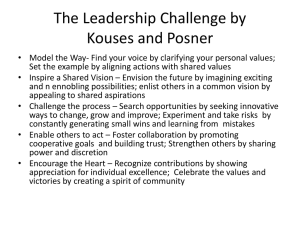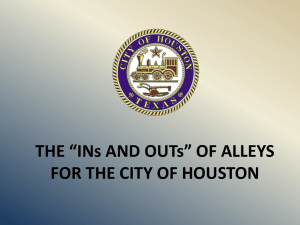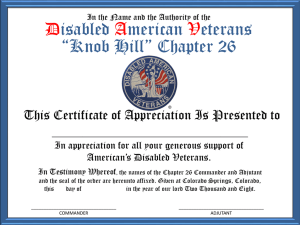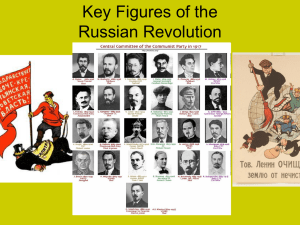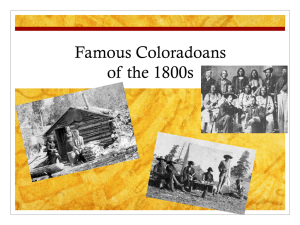mixon_sanborn_compressed
advertisement
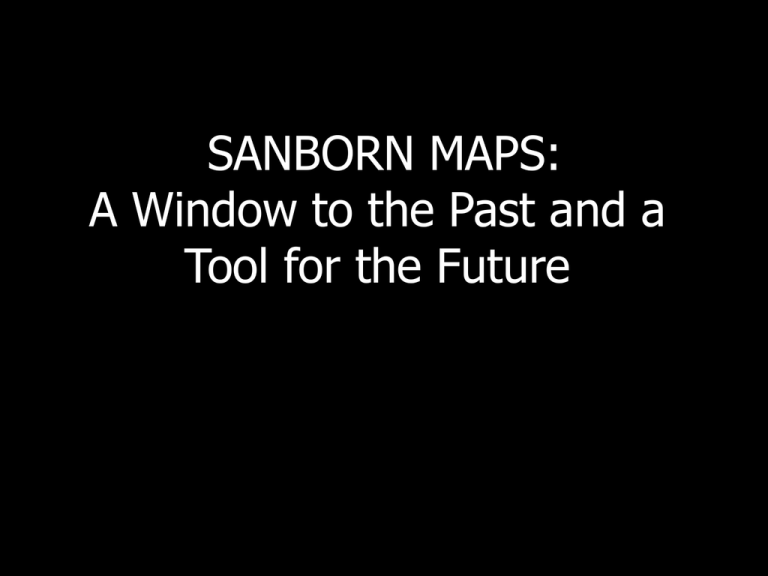
SANBORN MAPS: A Window to the Past and a Tool for the Future Talk Outline I. What are Sanborn Maps? II. History of Sanborn Company III. Details about the Sanborn Maps IV. Uses of the Sanborn Maps V. Understanding the Maps VI. CU’s Collection VII. Accessing CU’s Collection I. What are Sanborn Maps? Sanborn Maps Fire Insurance Maps Large Scale Detailed (50 feet to 1 inch) Date Back to the 1860s Updated Regularly Until 1950s London was prone to fires throughout its history Detail of painting from 1666 of the Great Fire of London by an unknown artist. Photo taken from Wikipedia Fire Insurance Maps emerged in London in the late 1700s From: http://www.oldmap.co.uk/detailmaps/londafterfiredetail.jpg •The American Insurance Industry spurred the growth of mapping companies in the late 1800s •Mapping companies supplied information to insurance underwriters. II. The History of the Sanborn Maps From: http://www.rotograph.org/Fire.jpg Insurance underwriters were interested in basing their rates according to the relative risk of fires in the commercial districts of American cities. From: http://www.tombstone1880.com/archives/hotel.jpg Daniel A. Sanborn founded the Sanborn National Insurance Diagram Bureau in New York City after successfully surveying Boston Portrait of Daniel A. Sanborn from: http://www.lib.berkeley.edu/EART/snb-intr.html Adopted the Name “Sanborn Map Company” in 1902 and Eventually Emerged as the Leader in the Field From: http://www.lib.berkeley.edu/EART/snb-intr.html The Sanborn Company’s success was due to •Absorption of other companies •Richly detailed and comprehensive maps •Highly accurate •Good management practices •Standardized symbolization Published a system of standards for accuracy in 1905 At Sanborn’s peak (1920s): •employed surveyors in every state •held a virtual monopoly Surveyors: -Worked anonymously -Names never appeared on maps -Surveyors occasionally gained notoriety or celebrity after leaving the Company Daniel Carter Beard From: Wikipedia “While working for them I not only saw all those places I had heard about but I made maps of them, made diagrams of all the homes in each town and city I visited. I took delight in putting into my records mention of real occupancy, genteel or disreputable. After four or five years of this work I knew a lot about our people, saints and sinners, rich and poor.” Dan Beard, Hardly a Man Is Now Alive, the Autobiography of Dan Beard (New York, 1939), p. 225 III. Details About the Sanborn Maps Most Sanborn maps were drawn at a scale of 50 feet to 1 inch until after WW II Quickbird Satellite Image Maps focus on urban areas “Map of Congested District of Salt Lake City Utah” 1911 The Sanborn Mapping Company (Scale 200ft to 1in) Maps Include: Details regarding the size, shape, and construction of commercial buildings, dwellings, and structures Paonia Colorado circa 1908 From ghostdepot.com Maps Include: Not just location but the composition of all buildings within a city or town Wood Frame Building Stone Building Fireproof Building Wood Frame w/ Iron Facade Maps Include: Noted strength of fire department and sometimes the number of engines or firefighters at each station Maps Include: Location of water and gas mains as well as things like sprinklers, hydrants, and alarms Maps Include: Labels on most public buildings: From landmarks to brothels (“Female Boarding”, “FB”, “Ill Fame”, “Bagnios” etc.) Reno, NV 1899 Maps Include: Street names, railroad lines, and Indian Reservations Some maps may included information about prevailing winds and population estimates http://www.lakemirabel.com/Railroad/Fishkill/20_Beacon_1921_t_m.jpg Sanborn Company resurveyed quickly after a disaster to note the buildings that had survived or been lost. For Example it took less than one week following the Chicago Stockyard fire of 1934 to produce updated map Chicago Stockyards 1947 Thematic Map of Chicago Stockyard Produced by the Sanborn Company (date unknown) Corrections and Updates: In 1930 Sanborn Co. began to allow correction plates The Decline of the Fire Insurance Maps: •The maps were costly •1929 stock market crash and depression •During WWII government placed restrictions on map production and building construction •Difficulty keeping pace with the post WWII population and development boom By the 1960s the insurance industry shifted away from using maps to assess risk IV. Uses of the Sanborn Maps Urban Morphology Studies the physical form of a city including • street patterns • buildings sizes and shapes • architecture • population density • patterns of land uses How does physical form produce or reproduce social forms? Urban Morphology Dr. Vaselka used Sanborn maps to examine how the the design and placement of courthouse squares in Texas affected sense of community. Quickbird Satellite Image of Denton, TX “Courthouse on the Square” The development of the Barrio Libre Neighborhood, Tuscon 1948 1919 1886 1901 Historical Sociology Studies the past to find out how societies work and change Photo fromhttp://www.economist.com Example: Washington DC “alley life” Alley Dwellings After the Civil War small dwellings were built in the allies that ran between many city blocks in D.C. The most common residents of these allies were poor or African American. Public perception of allies and inhabitants: • filthy • squalid • crime ridden • drunken • rampant immorality and disease Louse Alley Investigations into these “red light districts” were conducted in the early 1900s. Louse alley was considered one of the worst offenders. View of Louse Alley published in Charles Weller's 1909 expose Neglected Neighbors. Louse Alley “Bawdy houses” and “alley dwellings” were abolished during early twentieth century Reform Movements Louse Alley, then renamed Armory Place, was reconfigured as a minor street. Armory Place was demolished in the 1930s as an attempt to further rid the city of “alley dwellings” and as part of a “beautification” campaign Temporary housing was erected after WWII and for a time part of the area was used as dedicated open space. Louse Alley Currently the American Indian Museum stands on part of the site of Louse Alley. Before the Museum was built intensive archeological investigations of Lots 11 and 12 of Louse Alley were conducted in Reservation C Louse Alley -Mary Anne Hall’s Brothel (Lot 12) - Adjacent parcel theorized to be a trash dump for the brothel and location of a boarding house (Lot 11) Corks, foil and wire from champagne bottles Fine pottery Louse Alley Sanborn maps guided the excavation and are one of the few records of both “alley life” and “alley dwellers” Louse Alley All references and photos used were taken from the Smithsonian Institute: http://www.si.edu/oahp/madam/index.html http://www.si.edu/oahp/nmaidig/ Archeology As evident from the Louse Alley example the Sanborn maps frequently aid archeologist. From Footprint of a Sawmill:Archeological Investigation Into the Nurre Sawmill in Williamsburg, KY (by Grant, Keit, and Mauck) Historic Preservation “The process of preserving part of a community, from an individual building or part of a building to a whole neighborhood (including roadways and waterways), because of its historical importance.” (from urbanplan.org) Taos square in historic Georgetown awaits restoration Historic Preservation Since the maps contain such rich details regarding the size, shape, and construction of commercial buildings, dwellings, and structures they are an excellent resource for historic preservation. From: http://saahp.rwu.edu/saahp_gallery/cmsfiles/historicpreservation/01.jpg Genealogy The study or investigation of ancestry and family history. Campbell of Glenorchy Family Tree George Jamesone, 1635. Scottish National Portrait Gallery Genealogy Sanborn’s generally do not contain family names so they are often used when the address of an ancestor is known. Since the Sanborn maps only cover urban areas they are best for research city dwelling ancestors Treasure Hunting Bottle hunters and individuals who use metal detectors to find treasure often use the Sanborn maps to locate privy or outhouse sites. Compliments of “Digger” from “bottlebooks.com V. Understanding the Maps Understanding Sanborn Maps Sanborn maps contain a rich amount of information and detail In order to understand and interpret the maps you must make use of a complex legend VI. CU’s Collection CU’s Complete Collection •Largest collection of Colorado Sanborn maps outside of the Library of Congress •Presented as a gift by the Library of Congress in the late 1960s •The collection includes over 567 color maps produced between 1883 – 1931 CU’s Complete Collection The holdings include a nearly complete collection of what was mapped in Colorado More mapping was conducted in regions that were more populated or had significant mining activity in the late 19th and early 20th centuries* * Leadville’s peak number of map sheets date from the late 1800s The collection also includes some “ghost towns” Accessing Paper Maps Maps can be accesses from 9-5 M-F Jerry Crail Johnson Earth Sciences and Map Library Website: http://ucblibraries.colorado.edu/map/ Contact the library staff in advance Via email: maplib@colorado.edu Via phone: 303-492-7578 Accessing Paper Maps (Cont’d) •Sanborn maps do not circulate •Cannot photocopy the maps •Digital photographs are permitted •Some maps are also available on microfiche* and can be printed out Scanned collection includes: • 346 maps on 2,385 sheets, • 79 cities • 52 counties • spans 1883-1922 VII. Accessing CU’s Digital Collection A Quick overview of CU’s interface Digital Collection can be accessed at http://ucblibraries.colorado.edu/sanborn/
